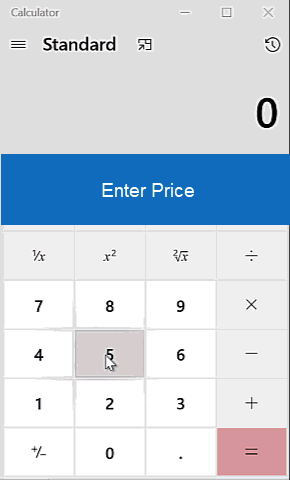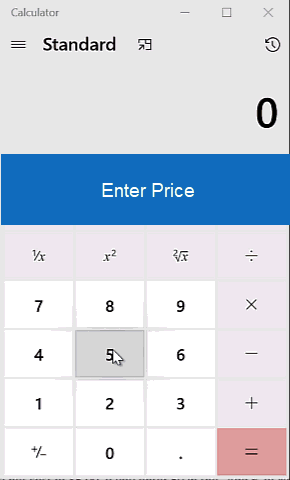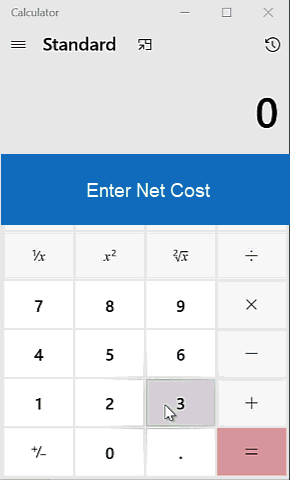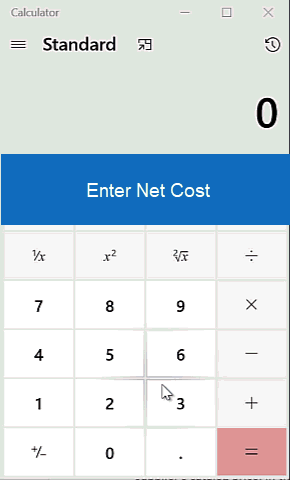In the Price Adjustments and Fees section, you are able to modify pricing to automatically display with a preset adjustment as well as apply fees.
Price Adjustments
Pricing on an ESP Website will automatically display the default Catalog Price, meaning the suggested retail price. You are also able to adjust price shown on the site based on the net cost. While the net cost (amount to be paid to the supplier by the distributor) will not be displayed on the site, the Catalog Price (also referred to as Price, List Price, or List) can be determined using one of five options.
Add a Percentage to the Default Catalog Price
This option enables you increase the price by a percentage based off the default catalog price. With this option, you are working solely with catalog pricing, net cost is not involved at all.
For example, a product has a supplier catalog price (list price) of $5.00. If you enter 5 in the "Add % of to the Catalog Price" box, then 5% of the catalog price of $5.00 will be calculated and that amount will be added onto the default catalog price. In the example above, 5% of $5.00 is $.25; so the new price of the item will be $5.25.
When you are finished making changes, click on the Save button and then click on the Make Changes Live link.
Here is a demonstration of how to check the pricing adjustment using a calculator:

Subtract a Percentage to the Default Catalog Price
This option enables you decrease the price by a percentage based off the default catalog price. With this option, you are working solely with catalog pricing, net cost is not involved at all.
For example, a product has a supplier catalog price (list price) of $5.00. If you enter 5 in the "Subtract % from the Catalog Price" box, then 5% of the catalog price of $5.00 will be calculated and that amount will be subtracted from the default catalog price. In the example above, 5% of $5.00 is $.25; so the new price of the item will be $4.75.
When you are finished making changes, click on the Save button and then click on the Make Changes Live link.
Here is a demonstration of how to check the pricing adjustment using a calculator:

Add a Percentage of Net Cost to the Catalog Price
This option enables you increase the price by a percentage based off the net cost. With this option, you are using a percentage of the net cost and adding it to the catalog price.
For example, a product has a net cost of $3.00 and a default catalog price of $5.00. If you select the “Add Percentage of Net Cost to the Catalog Price” option and then enter 5 in the percentage box, then 5% of the net cost of $3.00 will be calculated and that amount will be added onto the default catalog price of $5.00. In the example above, 5% of $3.00 is $.25; so the new price of the item will be $5.25.
When you are finished making changes, click on the Save button and then click on the Make Changes Live link.
Here is a demonstration of how to check the pricing adjustment using a calculator:

Add a Percentage of Net Cost to Net Cost as the Catalog Price
This option enables you increase replace the default catalog pricing by calculating a percentage of the net cost and then adding that percentage to the net cost. With this option, you are working solely with the net cost.
For example, a product has a net cost of $3.00. If you select the “Add Percentage of Net Cost to the Catalog Price” option and then enter 5 in the percentage box, then 5% of the net cost of $3.00 will be calculated and that amount will be added onto the net cost. In the example above, 5% of $3.00 is $.15; so by adding the $.15 to the net cost of $3.00, the new price of the item will be $3.15.
Here is a demonstration of how to check the pricing adjustment using a calculator:

Use a Profit Margin
This option enables you maintain a percentage between the net cost and catalog price.
For example, if a product has a net cost of $3 and the distributor wants to make a 50% profit, they will need to increase the list price to $6 so that they make 50% of the total sale. They charge $6 and then pay the supplier $3. The remaining $3 is their profit, which is 50% of the completed transaction.
It is important to note that this option will override the suggested profit margin and varying profit margins provided by the supplier. This means that if a product had five price breaks and different profit margins (for example, first quantity is 50%, remaining four quantities are 45%) and you have selected to have a profit margin of 40% applied to your site; all of the price breaks will now be a 40% discount.
Please keep in mind that the maximum profit margin is 99.
Flat Charges
The Flat Charges section enables you to establish a charge that is applicable to all products. Enter a dollar amount in the "per Product (Line item)" box and then type a name for the charge.

You are also able to control if customers are able to place orders with less than the minimum quantity. Use the dropdown to select to allow or not allow orders with less than minimum to proceed. If orders are allowed to with less than the minimum quantity, you are able to set a charge for these orders. Use the box with the dollar sign to add a fixed amount (such as $250) or use the box with the percent sign to have the charge calculated as a percentage of the total order.

If you would like a warning to appear when a customer is adding the product to their shopping cart and the quantity entered is less than the minimum, check the "Display warning text as" option and use the default message provide, or type a custom one. When a product is added to the shopping cart, a pop-up window called the Product Option Assistant will open. This window contains the product information and the user can enter a quantity and select additional criteria regarding options for the item prior to checking out. The charge you create in the Pricing Options and Display area will appear above the quantity in the Product Option Assistant.

Markups
Within this section, you can control and modify the supplier charges shown on your site using Markups. In the Markups section, click on the Add Charge Type link.

Select the charge type from the dropdown and modify the rate. You can increase or decrease the standard charge listed in your catalog by a percentage or an amount. In the example below, the provided set-up charges have been increased by 10%. Click on Done when you are finished.

When you are finished making changes, click on the Save button and then click on the Make Changes Live link.

